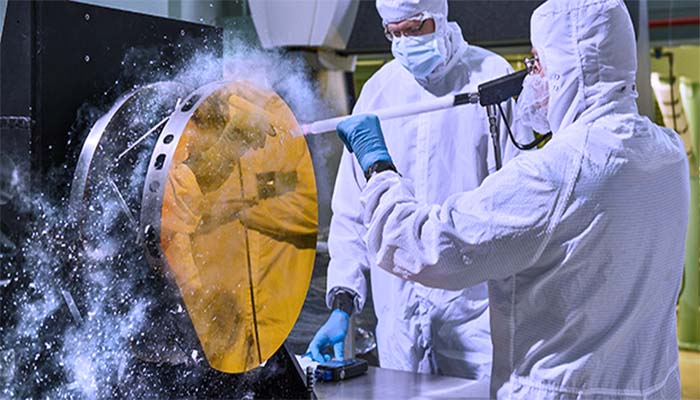Scientists have found a novel solution that reduces carbon dioxide emissions into the atmosphere. An Israeli business focusing on producing oxygen on the moon for future colonization has discovered a method that might dramatically reduce carbon dioxide emissions and steel industry costs.
The first stage in making steel is to produce iron, which is found naturally in the earth as iron oxides. Coal and iron oxides are traditionally mixed in blast furnaces to link oxygen molecules with carbon molecules.
The bioproduct of this process is carbon dioxide (CO2), which we all know is a significant greenhouse gas. Helios discovered that sodium, which is used to make table salt, may be used instead of carbon-rich coal.
They claim that sodium oxide is formed when sodium molecules in iron ore interact with oxygen molecules. After being split again into sodium and oxygen, the oxygen is released into the environment. The sodium can then be reused.
The firm’s ongoing work on a lunar oxygen-producing reactor, which intends to isolate oxygen from iron oxides found in lunar rock, inspired the concept of employing sodium in the steel industry.
Jonathan Geifman, co-founder and CEO of Helios, stated in a story published by The Times of Israel, that his sodium process required only 400 degrees Celsius, as opposed to the usual blast furnace procedure, which required heating the mixture to more than 1,200 degrees Celsius.
Helios’ laboratory already has a benchtop system. Furthermore, Helios intends to build a prototype to replace the conventional blast furnace at at least one overseas steel production site by the end of the year.
“We’re talking to huge steelmakers about establishing tiny showcase models within their production chains that will utilize their existing energy infrastructure,” he said.
Reducing Carbon Dioxide Emissions By Replacing Carbon With Sodium
Geifman went on to say that by replacing carbon with sodium, his company’s solution eliminated direct carbon emissions during this stage of the steel-making process.
It also decreased indirect emissions (from the coal or natural gas used to power the furnaces) by 80–90 percent and energy usage by 50 percent, according to Geifman.
While the technology is currently in its early phases of development, the CEO believes Helios’ method has the potential to lower steel production costs by “tens of percentage points.”
Even better, they’ve already put the technique through its paces with additional metals like copper and nickel.
The steel sector is responsible for around 7% of worldwide CO2 emissions. Its reliance on coal for the processing of iron ore into its basic metallic form makes decarbonization extremely difficult.
To reach the EU’s climate ambitions, it must develop and commercialize innovative low-CO2 technology within the next five to ten years.
The EU’s Climate Ambitions
The European Union (EU) has set lofty goals for lowering greenhouse gas emissions and mitigating climate change. The European Commission proposed the European Green Deal in December 2019. The goal is to make the EU climate-neutral by 2050. This indicates that by that year, the EU’s net greenhouse gas emissions will be zero.
As part of this goal, the EU has pledged to cut greenhouse gas emissions by at least 55% by 2030 compared to 1990 levels. In December 2020, the EU’s 27 member states agreed on this aim. The EU also intends to reach a 32% proportion of renewable energy by 2030, as well as a 32.5% increase in energy efficiency by the same year.
To attain these targets, the EU has enacted a variety of policies, including the implementation of a carbon price system, the promotion of renewable energy, the implementation of energy efficiency measures, and the development of a circular economy. The EU is also actively investing in research and innovation to aid the transition to a carbon-neutral economy.
Overall, the EU’s climate goals are significant, demonstrating the EU’s dedication to addressing climate change and supporting a sustainable future. To achieve these objectives, however, all sectors of society must work together, as must continued cooperation between EU member states and the international community.
Carbon Dioxide Emissions
The release of carbon dioxide gas into the atmosphere is referred to as carbon dioxide emissions. Carbon dioxide is a greenhouse gas that absorbs heat in the atmosphere. It thus contributes to global warming and climate change.
Carbon dioxide emissions are mostly created by the use of fossil fuels for energy generation and transportation. This includes coal, oil, and natural gas.
Deforestation, land use changes, and industrial operations such as cement manufacturing are also sources of carbon dioxide emissions.
Carbon dioxide accumulation in the atmosphere is a serious environmental concern. This is because it causes changes in the Earth’s climate, such as increasing temperatures. Also, sea level rise and more severe storms.
To counteract the effects of carbon dioxide emissions, the amount of carbon dioxide emitted into the atmosphere must be reduced. For example, by switching to sources of renewable energy and improving energy efficiency.
Decarbonization Ideas
Individual and communal initiatives can be used to reduce carbon dioxide emissions. Here are a few ideas:
Choose sources of renewable energy: Using renewable energy sources such as solar or wind power can greatly cut CO2 emissions. You might also think about purchasing green energy from your utility company.
Minimize your reliance on automobiles: transportation is a major source of carbon dioxide emissions. By taking public transportation, cycling, walking, or carpooling, you may lessen your carbon footprint.
Minimize your energy consumption: The more energy you consume, the more CO2 you emit. Simple acts like turning off lights when you leave a room, adopting energy-efficient equipment, and regulating your thermostat can all help you save energy.
Choose to support businesses that are committed to decreasing their carbon footprint and have implemented sustainable practices.
Consume a plant-based diet: Livestock agriculture contributes significantly to CO2 emissions. Reduce your meat consumption and adopt a plant-based diet to help lower your carbon footprint.
Plant trees: Because plants absorb carbon dioxide from the atmosphere, increasing the number of trees planted can help offset carbon emissions. You may help plant trees in your town by volunteering or donating to tree-planting initiatives.
Urge your local and national governments to take action on climate change. This is done by campaigning for policies that decrease carbon dioxide emissions. This include carbon pricing, renewable energy incentives, and transportation and industry emissions controls.



